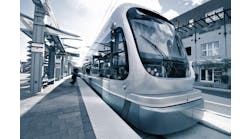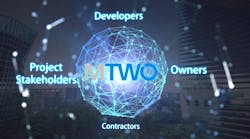This year’s ITS America Annual Meeting was in full swing yesterday as the exhibit hall floor opened, and several tracts of educational sessions ran throughout the day. As in years past, this conference presents a forum for agencies and DOTs to share information with technology providers and intermediaries in effort to move our national infrastructure forward at the speed of progress.
The speed of progress was actually a topic of some debate. In a session titled “The Imperative Role of Standards in the Connected/Automated Vehicle Landscape,” leaders from the automotive and technology segments mulled what it will ultimately take for the U.S. national infrastructure to be readied for full connectivity. At present, standards are being discussed and drafted, though this forum was unfortunately light on details thereof. However, moderator Kevin Cosgriff made the point that “[we] can’t replace same with same and expect it to serve a 21st century society; we ought to be thinking of what’s to come with regard to infrastructure. We need get over the last century.”
Seems an obvious point on the surface, but when one considers how rapidly, say, a smartphone gets replaced vs. how rapidly any given city roadway gets a smart design upgrade, one must take pause in the face of such dissonance. Audi’s Brad Stertz said, “The era of automated vehicles is rapidly advancing. Companies don’t invest $80 billion in R&D for no reason. We can’t wait for infrastructure decisions to be made for us; we have to prep roads now.”
Stertz went on to address the cellular vs. 5.9 GHZ debate, saying that locking this down is crucial to U.S. competitiveness; he cited the degree to which China is digging in on this, having already reserved two bandwidths for connected infrastructure on a national level. “This is critical to the safety of roads and the safety market in the U.S.,” he said.
I intuited some subtext here. China has a leg up on us, as much of our infrastructure is city/state/local-owned and operated, and therefore the idea of adaptation to a national regulation is, perhaps, unobtainable. China, on the other hand, has no problem exercising national control. Is this an instance where a Communist political system is more adept at progress than a Democratic/Capitalist system? Or is it merely indicative of our present administration’s apathy toward interparty compromise? What would happen if the federal government came in and dictated the future of connected infrastructure? The answer might well be that some big folks would make less money, which is what happens when market forces do not dictate such things.
The argument for allowing market forces to make this decision—think of the HD DVD vs. Blu-Ray fight a decade ago—was made by Allied Information’s Bryan Mulligan, who posited that “for the first time we are not working in a bubble of our own. We have partners with direct stakes in the game [such as Ford and Audi] who are looking for opportunity and change.” The Ford Motor Company’s declaration of intent to have its 2022 models available with on-board V2X technology tells us, said Mulligan, that we must work with car companies and, in essence, “follow their lead.”
The fear, he went on to say, is that unless big change is made now, when those 2022 models hit the roads, "what we’ll hear is crickets," because even if the tech is on the car, the world around it will have no means of hearing what that tech has to say.
But is following the lead of big business the correct course? Recent history has shown that what lies in the public interest and what lies in the interest of large corporations is separated by a wide and murky bog. Think of Tesla and it’s irresponsible marketing of a driver-assist system as “Autopilot,” connoting a human remove from control and responsibility, or that same company’s unwillingness to validate the use of LiDAR, simply because it’s pricey and they are deep, deep, deep in the red. (Or go further and think about the banking industry.) How can auto manufacturers be tasked with taking the lead here? I take no stance on this, though I do recognize that speed of technology is directing decision-making in the car industry, whereas it is ostensibly not for DOTs and agencies that are dealing with a trickle of funding meant to flood a moat the size of a river.
“Infrastructure must embrace the speed of change,” Mulligan said, yet asked, “Could they ever afford it?” He held up a cellular on-board device in one hand and a DSRC device in the other, neither as large as an iPod Nano, and asked how difficult could it be simply put both on every piece of road and bridge connected infrastructure as a means of “futureproofing” our national network. His was a good point—we do need to plan for what we cannot entirely know—but one thing we do not yet know is what the costs will be. And we need to because we all know it comes down to money, rather than will, it always does.
This and other complicated topics will press on as ITS America’s Annual Meeting moves into today’s sessions. Despite a perhaps inevitable inability to draw certain conclusions, the discussions are earnest and this forum for progress is illuminating.



